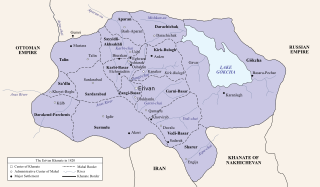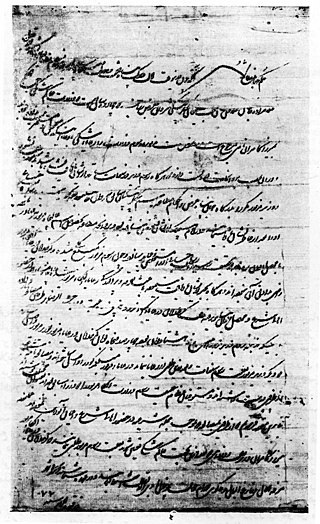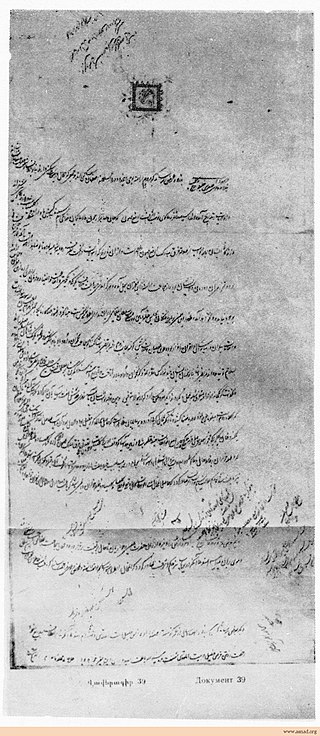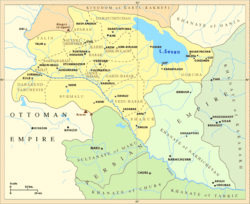
The Karabakh Khanate was a khanate under Iranian and later Russian suzerainty, which controlled the historical region of Karabakh, now divided between modern-day Armenia and Azerbaijan. In terms of structure, the Karabakh Khanate was a miniature version of Iranian kingship. The administrative and literary language in Karabakh until the end of the 19th century was Persian, with Arabic being used only for religious studies, despite the fact that most of the Muslims in the region spoke a Turkic dialect.

The Nakhichevan Khanate was a khanate under Iranian suzerainty, which controlled the city of Nakhichevan and its surroundings from 1747 to 1828.

The Erivan Khanate, also known as Chokhur-e Sa'd, was a khanate that was established in Afsharid Iran in the 18th century. It covered an area of roughly 19,500 km2, and corresponded to most of present-day central Armenia, the Iğdır Province and the Kars Province's Kağızman district in present-day Turkey and the Sharur and Sadarak districts of the Nakhchivan Autonomous Republic of present-day Azerbaijan.

The Shirvan province was a province founded by the Safavid Empire on the territory of modern Azerbaijan and Russia (Dagestan) between 1501 and 1736 with its capital in the town of Shamakhi.

The province of Karabakh was a north-western province of the Safavid Iran, centered on the geographic region of Karabakh.

Qarachaqay Khan was a military commander in Safavid Iran of Armenian origin. He was known for his great collection of porcelain items and loyal service to Shah Abbas I. Qarachaqay Khan was killed while commanding an expedition against the Georgian rebels.
Qazaq Khan Cherkes was a military commander in Safavid Iran of Circassian origin, who also served as the governor (beglarbeg) of Shirvan (1624–1633) and Astarabad (1639–1640). A high-ranking member of the gholam military corps, he was furthermore appointed head of the Qaramanlu and Keneslu Qizilbash troops by then incumbent king Abbas I as part of the latter's policy to diminish the political influence of the Qizilbash. In 1632, during king Safi's bloody purges, his relative, the prominent Circassian courtier Yusuf Agha was murdered, while Qazaq Khan Cherkes was deposed and imprisoned in 1633. He nevertheless later returned on the political scene in the last years of Safi's reign, when he was given a new governorship in 1639. His son Najafqoli Khan Cherkes would hold several influential positions as well.

Najafqoli Khan or Najafqoli Khan b. Qazaq Khan Cherkes was an Iranian gholam of Circassian origin, who served as beglerbeg (governor) of Shirvan and of the Erivan Province. He was the son of the Safavid-Circassian military commander and governor Qazaq Khan Cherkes. In total, he held the governorship of Shirvan for 7 years.

Khosrow Soltan Armani, also known as Khosrow Khan, was a 17th-century Safavid official, military commander, and gholam of Armenian origin. He held numerous posts at various times. First, he served as the prefect of the Bakhtiari tribe for a lengthy period. Then, he served as a steward of the Javanshir tribe in Karabagh. Later, he held the post of "master of the hunt" and was given the governorship of Abhar (Soltaniyeh). Lastly, he also served as the governor (beglarbeg) of Shirvan from 1643 to 1653. During his governorship in Shirvan, Khosrow participated in the successful Safavid offensive during the Russo-Persian War of 1651–1653, which resulted in the Russian fortress on the Iranian side of the Terek River being destroyed and its garrison expelled.
Fereydun Khan Cherkes was a Safavid official and military commander of Circassian origin, who served as the governor (beglarbeg) of Astarabad in 1605/06–1620, during the reign of king Abbas I.
Mohammad Khan Tokhmaq Ustajlu, also commonly known as Tokhmaq Khan Ustajlu, was a 16th-century Iranian official, diplomat and military leader from the Turkoman Ustajlu tribe. He was appointed as governor (beglarbeg) of Erivan Province in 1568–1575. Thereafter, he led an embassy to the Ottoman Empire. On his return, he participated in some judicial developments, and was reappointed as governor of Erivan Province in 1578. In the same year, he served as main commander at the Battle of Çıldır during the Ottoman–Safavid War of 1578–1590, where his army was routed. A few years later, in 1583, Mohammad Khan Tokhmaq's second tenure over the Erivan Province was brought to an end due to encroachments by the Ottomans, who controlled the province until 1604.
Aslamas Beg, also known as Aslan Khan, was a Safavid official and military commander of Georgian origin. A scion of the Orbeliani family, Aslamas was the second son of Vakhushti Khan, the former governor of Shushtar.

Abdollah Khan Ustajlu was a high-ranking Iranian dignitary of Turkoman origin, who served during the reign of king (shah) Tahmasp I (1524-1576). He successively held the posts of amir al-omarāʾ (commander-in-chief) and divanbegi, before becoming the governor of Shirvan from 1549 until 1565 or 1566.

The Erivan Province, also known as Chokhur-e Sa'd, was a province of Safavid Iran, centered on the territory of the present-day Armenia. Erivan (Yerevan) was the provincial capital and the seat of the Safavid governors.
The province of Azerbaijan was a province in the northwestern part of Safavid Iran, serving as one of its principal administrative areas. The city of Tabriz was the provincial capital, as well as the capital of the Safavids until 1555. The Ottoman Empire occupied Tabriz and a large portion of Azerbaijan from 1588 to 1603; as a result, the authority of the governor-general of Azerbaijan was mainly restricted to Ardabil.
Soleyman Khan Ardalan was the Ardalan beglerbeg (governor) of Kurdistan from 1637 to 1657. He is notable for having founded the city of Sanandaj in 1636/37, which would serve as the capital of the Ardalan principality until its dissolution in the 1860s. He was the cousin of Khan Ahmad Khan Ardalan, who had previously served as the governor of Kurdistan from 1617 to 1637. Following the Iranian–Ottoman Treaty of Zohab in 1639, Soleyman Khan lost the western half of his domain to the Ottomans, which included Shahrezur, Qaradagh, Qezelja, Sarutchek, Kirkuk, Rawandez, Emayideh, Koy, Harir and the western portion of Avraman. The extent of Kurdistan was thus now restricted to that of Sanandaj, Marivan, eastern Avraman, Baneh, Saqqeh, Javanrud, and some of the Jaf confederacy.

Kaykhosrow Khan Cherkes was an Iranian gholam of Circassian origin, who served as beglerbeg (governor) of the Erivan Province from 1648 to 1653 during the reign of Shah Abbas II.
Heydar Qoli Khan was the first khan of the Nakhichevan Khanate, ruling from 1747 to 1762 under Iranian suzerainty.
The Great Surgun was the forced deportation of the population from Eastern Armenia to the territory of the central and northern parts of Safavid Iran, which was carried out in 1604-1605 by the order of Shah Abbas the Great during the Ottoman–Safavid War (1603–1618).
Kangarlu is a Turkic tribe that resides in the Azerbaijan and Qom-Varamin regions of Iran. They were originally a clan of the prominent Ustajlu tribe of the Qizilbash tribal confederacy.














